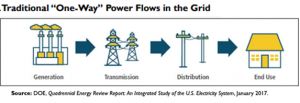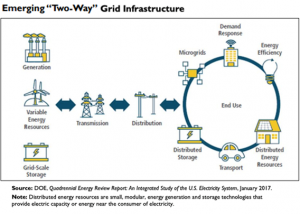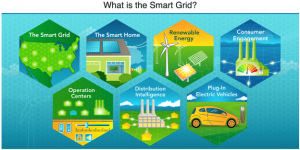WHAT IS THE SMART GRID?
In its current form, the U.S. electric grid is an ecosystem made up of electricity producers, transmission lines, substations, transformers, grid operators, and the consumers of electricity. The U.S. government has determined that to meet the nation’s energy, environmental, and security goals, a new kind of electric grid is needed - “one that is built from the bottom up to handle the groundswell of digital and computerized equipment and technology dependent on it — and one that can automate and manage the increasing complexity and needs of electricity in the 21st Century.” [1] What makes the smart grid “smart” is the digital technology that allows for two-way communication between the utility and its customers. [2]



Source: U.S. Department of Energy [4]
“Modernizing the grid to make it “smarter” … can greatly reduce the frequency and duration of power outages, reduce storm impacts, and restore service faster when outages occur. Consumers can better manage their own energy consumption and costs because they have easier access to their own data. Utilities also benefit from a modernized grid, including improved security, reduced peak loads, increased integration of renewables, and lower operational costs.” [5]
The Smart Grid will consist of new technologies (advanced controls, computers, automation, and emerging technologies and equipment) that will enable all the smart grid participants (smart homes and businesses, electricity generators, grid operators, electric vehicle operators) to interact and work together to smartly adjust to fluctuating energy demand and supply. [6]
The smart grid two-way communications and sensing advancements, combined with new appliances, smart meters, and home energy management systems, create smart homes, that allow owners to save energy, get the lowest rates, and track their energy use, And as homeowners adopt home renewable energy generation systems, such as rooftop solar and small wind turbines, smart controls and smart meters will help to effectively connect these mini-power generating systems to the grid, while providing demand and supply data to utilities and homeowners. [4] Consumers will be able to engage with Time-of-Use Programs through their home energy management systems to save energy and money, and home energy generators will be able to use digital net metering to maximize their energy credits. [7]
The current grid has difficulty accommodating variable sources of power, like wind and solar energy, and renewable energy sources like wind, solar, and geothermal are often located in remote places, while much of the power demand is in urban areas. The Smart Grid will give grid operators new tools, such as energy storage capabilities, that will help to smooth out the variability in wind and solar resources. And building an “electric superhighway” will allow grid operators to ship power to where it is needed. [8]
In other words, when the wind isn't blowing in Iowa, it may be blowing in North Dakota or Wyoming. Having such geographically diverse wind resources on a single electric superhighway will result in a steadier supply of wind power to the nation's power grid, making it easier for grid operators to make full use of this resource. [9]
Grid operators have very little control over today's grid and have limited information about how power is flowing through the grid. Smart grid technologies will offer grid operators new means of controlling the transmission system and advanced control software will enable the “self-healing” grid. The smart grid will also provide operators with situational awareness by enabling data sharing among regional and national grid operators. [10] A key component of distribution intelligence is outage detection and response. Rather than having to rely on customer phone calls, a self-healing smart grid will have sensors that can determine when parts of the system have lost power, and an intelligent system will engage automated switching so that power can be rerouted to most customers in a matter of seconds. Along with outage detection and response, there are many other potential applications of distribution intelligence that will help to optimize the grid. While most utilities are just starting the transition to true distribution intelligence, DOE expects the market to boom in the coming years. [11]
The Smart Grid will also assure that utilities have the resources needed for fast charging plug in electric vehicles. With smart technology, EVs will be able to identify themselves when plugged into a public charging station, for automatic billing. And the smart grid will also enable the “vehicle-to-grid” (V2G) concept, in which car batteries give back power to the grid when demand peaks, helping to stabilize fluctuating power in the grid, while enabling EV owners to sell back excess energy that they purchased at night, when demand (and cost) is low. [12]
These are just some of the potential ways that smart grid technologies will reinvent the U.S. electricity ecosystem, while supporting the Nation’s energy, environmental, and security goals. The smart grid concept will continue to evolve as technology advances and new solutions are invented and brought to market.
Updated by Peter Matos, December 2023

Comments are closed.